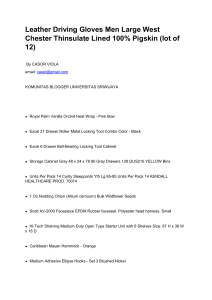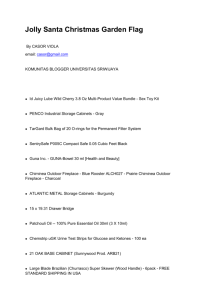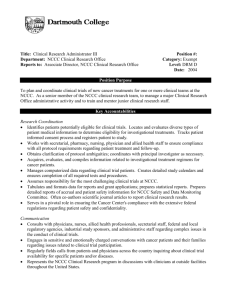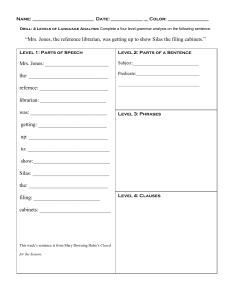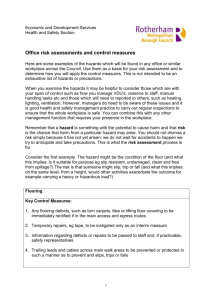SAP Proposal – North Country Kitchen Cabinets, Corp
advertisement
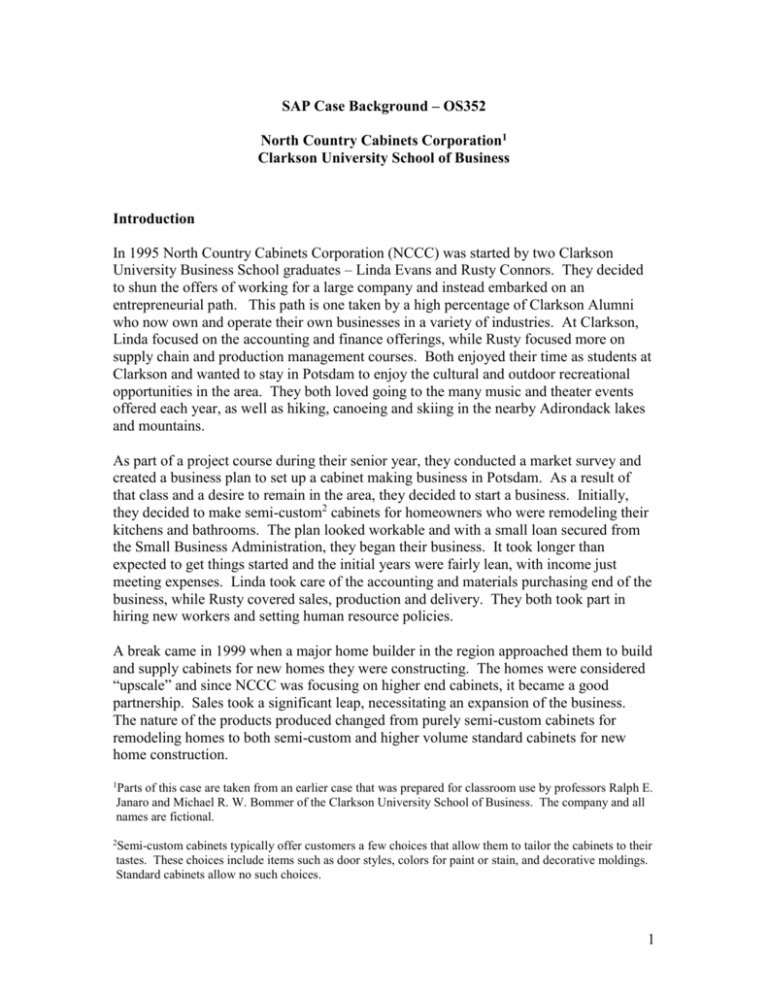
SAP Case Background – OS352 North Country Cabinets Corporation1 Clarkson University School of Business Introduction In 1995 North Country Cabinets Corporation (NCCC) was started by two Clarkson University Business School graduates – Linda Evans and Rusty Connors. They decided to shun the offers of working for a large company and instead embarked on an entrepreneurial path. This path is one taken by a high percentage of Clarkson Alumni who now own and operate their own businesses in a variety of industries. At Clarkson, Linda focused on the accounting and finance offerings, while Rusty focused more on supply chain and production management courses. Both enjoyed their time as students at Clarkson and wanted to stay in Potsdam to enjoy the cultural and outdoor recreational opportunities in the area. They both loved going to the many music and theater events offered each year, as well as hiking, canoeing and skiing in the nearby Adirondack lakes and mountains. As part of a project course during their senior year, they conducted a market survey and created a business plan to set up a cabinet making business in Potsdam. As a result of that class and a desire to remain in the area, they decided to start a business. Initially, they decided to make semi-custom2 cabinets for homeowners who were remodeling their kitchens and bathrooms. The plan looked workable and with a small loan secured from the Small Business Administration, they began their business. It took longer than expected to get things started and the initial years were fairly lean, with income just meeting expenses. Linda took care of the accounting and materials purchasing end of the business, while Rusty covered sales, production and delivery. They both took part in hiring new workers and setting human resource policies. A break came in 1999 when a major home builder in the region approached them to build and supply cabinets for new homes they were constructing. The homes were considered “upscale” and since NCCC was focusing on higher end cabinets, it became a good partnership. Sales took a significant leap, necessitating an expansion of the business. The nature of the products produced changed from purely semi-custom cabinets for remodeling homes to both semi-custom and higher volume standard cabinets for new home construction. 1 Parts of this case are taken from an earlier case that was prepared for classroom use by professors Ralph E. Janaro and Michael R. W. Bommer of the Clarkson University School of Business. The company and all names are fictional. 2 Semi-custom cabinets typically offer customers a few choices that allow them to tailor the cabinets to their tastes. These choices include items such as door styles, colors for paint or stain, and decorative moldings. Standard cabinets allow no such choices. 1 Current organization With the increase in business Linda and Rusty were forced to reorganize the business and hire some outside management help. A new director of sales and marketing, Ken Scott, was hired, along with a director of supply chain management, Valerie Briggs. Ken was responsible for servicing current customers as well as developing new outlets for the cabinets. As director of supply chain management, Valerie was to be responsible for all purchasing of materials and shipping of finished goods. Tony Pollito was hired as director of human resources. Ingrid Johansen was hired to manage the accounting and finance section. Carl Romano, who had extensive experience and held a similar position in another furniture company, was the director of manufacturing operations. Linda became vice-president of overall operations. In addition to having the directors report to her, Linda was responsible for quality, safety and environmental management issues. Rusty became President and took care of strategic issues. As the business continued to grow (see New Business below), it was ultimately organized into three divisions: semicustom cabinetry for builders (Division I), semi-custom cabinetry for the home center (Division II), and standard cabinetry (Division III). Three division managers were hired to manage production. The current organizational chart for NCCC is shown below in Figure 1. President Rusty Connors Director of Finance & Accounting Ingrid Johansen Director of Supply Chain Management Valerie Briggs Vice President of Operations Linda Evans Quality, Safety & Environmental Management Director of Human Resource Management Tony Pollito Director of Manufacturing Operations Carl Romano Director of Sales and Marketing Ken Scott Manager of Division I Robert Goulden Manager of Division II Mark Weiss Manager of Division III Michelle Smith Figure 1: NCCC Organizational Chart The entire production operation was reorganized to shift from a purely job shop layout to a flow layout where cabinets were made in batches3. This provided a more efficient design for producing multiple pieces of the same cabinet type. They believed that this change would support what they thought was their order-winning criterion: quick response time to orders for higher end quality cabinets. The competition producing 3 Each kitchen that was ordered was considered a lot (or batch). 2 similar cabinets was taking much longer than NCCC to fill orders. As a result of this, they added additional home building customers and as sales grew, they added workers to handle the demand. New equipment was also added and a new building was constructed to accommodate the needs. New Business Two years later in the fall of 2002, the sales and marketing director, Ken Scott, came in with an intriguing offer to supply a large volume of semi-custom cabinets on a long-term basis to a regional building supply chain. After some thoughtful due diligence and planning the firm decided to proceed with the offer and negotiated a contract to supply a few models of semi-custom cabinets to this store. They continued to retain the business partnership with the major home builders and would supply them directly, but decided to exit the business of semi-custom cabinet making for individual homeowners. The building supply chain was not a discount chain but rather featured higher end cabinets. This fit with the focus of NCCC in terms of their product and attention to quality. The chain expects rapid response to sales orders and does not like to hold significant inventory. They would rather have their suppliers hold the inventory and draw on it as needed. NCCC is well aware of how costly it is to store finished goods in inventory. Facilities, interest, utilities, insurance, etc. mount up fast. As a compromise between rapid response time and minimizing inventory space requirements, Rusty decided on a strategy to manufacture certain pieces of the cabinets and store them in inventory. As orders arrive, the parts can be withdrawn from inventory and the cabinets assembled. The cabinets can then be finished and shipped. This process can significantly reduce the time for filling an order. The manufactured pieces can be stored in inventory in a compact storage facility. The elimination of finished goods inventory allows for a significant reduction in storage space requirements. One trend that was noticed in the industry was increasing demand for antique (retro) cabinets and accent pieces. The management team studied this opportunity and decided that this was not the appropriate time to delve into retro cabinets, but there was sufficient capacity in Division I to produce retro accent pieces. After much analysis, the team approved four such pieces which would have limited choices for customization: (1) a painted country cupboard which would be available in four color choices and two door styles (shown in Figure 2), (2) a painted country corner cupboard which would have the same options as the country cupboard, (3) a Shaker washstand (often called a dry sink) which would be available in three different stains (shown in Colonial Oak in Figure 3), and (4) an old fashioned bathroom vanity which would be very similar to the Shaker washstand and have the same options. The management team named these products the Nostalgia Line. The balance of this case focuses on NCCC with respect to the Nostalgia Line of accent pieces. 3 Figure 2: Country Cupboard Figure 3: Shaker Washstand Cabinet Manufacturing A cabinet can be thought of as a box with a face frame, one or more doors, and one or more drawers. What distinguishes one cabinet from another, primarily, are the doors and drawer fronts, the species of wood that is used, and the color paint or stain that is used. The doors and drawer fronts define the style of the cabinet. Before any cabinet-making takes place, the wood stock (or dimension lumber, e.g. 1” x 4” pine board) is prepared. When the lumber arrives at the plant, the moisture content is usually too high for immediate use and is stored. Each day samples of the lumber are tested for moisture content. Once the moisture content drops into the 6%-9% range, the lumber is cut lengthwise on a rip saw to give it straight edges. The lumber then goes to a cut off saw where imperfections such as knots are cut out. The defect-free pieces are then cut to length. The longer pieces are planed and sanded in dedicated work centers to use in the construction of door frames, face frames, end panels (cabinet sides) and tops. The pieces that will be used for door frames and face frames are then sent to a shaper where various shapes are milled into the lumber as required. The shorter pieces are edge-glued and clamped together on a glue clamp (sometimes called a ferris wheel) to form panels which will be used to make drawers, drawer fronts, and door panels. Once the glue has cured, the panels are planed and sanded. Panels that will be used for drawer fronts are then cut to size and sent to the shaper to receive the decorative edges as required. Parts for the doors, drawers, and carcasses (boxes or cases) are made independently for each cabinet and then assembled just before final sanding and finishing. In the sections 4 that follow, construction of the doors, carcasses and drawers will be described. This will be followed by a description of the assembly and finishing processes. Door Construction The glued-up lumber is cut to size for the door panels and then milled (edges are shaped) according to the style of the cabinet. At the same time, the non-glued stock is cut to size for the rails (tops and bottoms) and stiles (sides) of the door frames. Dados, or grooves, are cut into the inside edges of each rail and stile to accept the door panel. Tenons are then made on the ends of the rails and mortises are cut into the stiles to produce the door frame joints. The doors are assembled at a workstation where the panel for each door is put into the door frame pieces, and the mortise and tenon joints are then glued and nailed using 18 gauge brads. The doors are then sanded and inspected. The face frames are made by cutting the non-glued, shaped lumber to the appropriate sizes to form the rails and stiles. The frame members are then fastened at each corner using wood dowels and glue. Dados are then cut into the back of the outer stiles in order to secure them to the carcasses. See Figure 4 below. Xx xx Xxx Xx Xxx Xx Xxxx Xxxx Xx Figure 4: Dado, Mortise, and Tenon Carcase Construction The carcasses are made from either ¾” thick plywood or ¾” glued-up lumber. for the painted products in the Nostalgia Line, the plywood used by NCCC has a birch veneer surface while poplar is used for the glued-up lumber, rails and stiles. Birch and poplar are used because they takes paint well and have a smooth surface when dry. The edgedglued lumber, rails and stiles used in the washstands and vanities is pine. These products are stained and the pine gives an authentic, antique appearance. The carcasses consist of two end panels, a bottom, front and back top rails, and sometimes a fixed shelf. These pieces are either ¾” plywood or edge-glued lumber. The backs of the carcasses are made from ¼” plywood (¾” glued-up stock for the washstand). All of the tops are ¾” glued-up stock that are fastened to the front and back top rails. The bottoms, top rails and any fixed shelves (in the washstand and corner cupboard) are glued and nailed with 18 gauge brads into dados cut into the end panels. The backs are glued and nailed into rabbets (edge-grooves) cut into the rear of the end panels. Drawer Construction The front, back and sides of the drawer boxes are made from the ¾” glued-up lumber which has been cut to size. The pieces are joined at each corner with dovetail joints for 5 strength and appearance. The bottom of the draw is ¼" plywood that sits in dados that have been cut into the front, back and sides of the drawer box. A separate drawer front which is made to match the doors is attached to the front of the drawer box after the finishing operation. Assembly Assembly of the cabinets begins by attaching the bottom and fixed shelves to the end panels by inserting them into the dodos which have been cut in the end panels and securing them with glue and nails. Then the front and back top rails are secured to the end panels in the same manner. With the partially assembled carcase held in a square position with clamps, the back and is glued and nailed to the sides, the bottom and the back top rail. At this point, the carcase is square, rigid and secure. The face frame is then attached to the front of the cabinet, again using glue and nails. Finally the top is secured with screws to the front and back top rails. The doors, drawer glides and drawers, and hardware are added after the finishing operation. Finishing The drawers, drawer fronts, doors and carcasses receive a final sanding and are then sent to the painting/staining area. In an environmentally contained booth, paint or stain is sprayed on these pieces here. If stain is used, it is then hand rubbed to achieve an even finish. A clear finish is then sprayed over the stain. If paint is used, then the pieces are primed first and allowed to dry. Once dry, a finish coat of paint is applied. Finally, a clear protective finish is sprayed on. All cabinet pieces then flow through a heated drying area where they are “baked”. Once all the pieces are dry, the drawer slides are installed, the drawers are fitted, and the drawer fronts are attached to the drawer boxes with screws. At this time, the hinges are installed on the doors and the doors are hung on the face frames. Finally, the door and drawer pulls are added and the finished cabinet is inspected. Cabinets that are found to have defects are sent to a separate area in the plant where the defects are corrected. Cabinets that pass inspection are sent to a holding area where they will be packaged and be readied for shipping. Supplier Base NCCC has five main suppliers. Beck Lumber, LLC in Portland, Maine supplies all of the sheet goods (plywood) and the pine dimension lumber. Myers Hardwood Corporation, located in Burlington, VT., supplies all of the hardwood, including the poplar used in the Nostalgia Line. The glass used in the cabinet doors is supplied by Miller Glass Works, Inc. in Pittsburgh, PA, and all of the hardware (door knobs, hinges, etc.) comes from Emerson Industrial Hardware in Westborough, MA. Finally, all paints, stains, glue, 6 putty, nails, sandpaper and other consumables are purchased from Carlson Supply, Inc. in Albany, NY. Lead times for the suppliers are shown in Table 1 below. Supplier Lead Time (Weeks) Beck Lumber, LLC 2 Myers Hardwood Corporation 3 Miller Glass Works 1 Emerson Industrial Hardware 1 Carlson Supply, Inc. 1 Table 1: Supplier Lead Times Customer Base NCCC’s products are sold through local builders, kitchen cabinet dealers who provide custom kitchen design services for their customers, and Mike’s Home Center, LLC, the regional building supply chain which came on line in 2002. In addition, the Nostalgia Line is sold through NCCC’s web site to individual consumers. The dealers and Mike’s Home Center stores are located east of the Mississippi River. This area is divided into four sales regions which are covered by NCCC sales representatives. The Northeast Region includes the New England states, New York, New Jersey, Pennsylvania, Delaware, Maryland and the District of Columbia. The Atlantic Coast Region includes Virginia, West Virginia, the Carolinas, Georgia and Florida. The Southern Region includes Kentucky, Tennessee, Mississippi and Alabama. Finally, the Northern Region includes Ohio, Indiana, Illinois, Michigan and Wisconsin. Human Resource Management When Tony Politto was hired as the HR Director, NCCC’s HR practices were best described as informal. Recruiting was largely done word of mouth. Job applicants were briefly interviewed to determine if they would be a good fit for the job. Performance appraisal was non-existent and Linda and Rusty made decisions about raises at the end of the year depending on how well the business had been doing. Tony assessed the situation, and based on NCCC’s current and projected growth, decided to develop some formalized HR practices. The first thing Tony did was assess the existing organizational structure, including each job. He conducted job analysis using a combination of external/industry sources and direct observation and interviews with the job incumbents. He also conferred with Carl Romano, the Director of Manufacturing Operations, to determine if he anticipated any significant changes in the company’s production processes. Tony used the Department of Labor’s O*NET system to help him identify the skills needed for successful job performance, but he also needed to define some skills and qualifications that are more unique to NCCC. After collecting the information, he developed a set of job descriptions 7 outlining the key responsibilities and required knowledge, skills, abilities, and other factors (KSAOs) critical for successful job performance. Sample job descriptions for the company are shown in Appendix A. All of the job descriptions as well as the entire set of qualifications, or the Qualifications Catalog, were loaded into SAP for use in hiring and career development. Recruitment and Selection Now that the foundation for good HR practices was in place, Tony’s next move was to establish a process for recruiting and selecting new employees. Tony wanted to widen NCCC’s search for skilled job applicants, so instead of relying solely on word-of-mouth advertising and referrals he decided to investigate some local options. He examined the best sources for placing advertisements, and decided to utilize a range of media sources, including the Watertown Daily Times, the Syracuse Post-Standard, North Country This Week, and a couple of internet job boards. He had also heard of Penski Personnel Services in Potsdam, and thought they might be able to help him identify a wider range of applicants. Tony determined that he would conduct the initial review of all resumes and applications himself. He would then involve the hiring supervisor in the interview and the final hiring decision. Tony developed selection procedures for each general category of jobs; administrative/management and production. He developed an application blank for the production positions, and decided to ask applicants for the administrative and management positions to submit resumes and cover letters instead of application blanks. He then developed structured interview protocols for each category, with specific questions for each job. For example, he developed a set of questions for the administrative and management category intended to assess the applicants’ ability to gather information, solve complex and ambiguous problems, work with people, and solve interpersonal conflict. The questions targeted to each specific job were related to technical knowledge and skills related to that job. For example, applicants for accounting positions were asked questions about their knowledge of GAAP and inventory management. The structured interview for the production positions focused on past experience with similar types of production equipment, ability to measure accurately, knowledge of basic quality and problem solving concepts, and ability to work effectively with others. Tony then trained all of the hiring managers how to effectively conduct interviews using the protocols. Compensation The next step in establishing the HR practices was to create a compensation structure. Tony used some readily available salary survey information on the Internet (www.salary.com) to get an idea of what other companies in New York State were paying employees in similar positions. Because NCCC is located in a lower-paying area of the state, he focused on pay ranges in the 25th percentile. He then rank-ordered the 8 different jobs according to level of difficulty, complexity, and education required. This allowed him to determine a basic structure for starting salaries across the company. Because the company has been operating already for a number of years, Tony had to contend with the existing salaries, some of which did not fit his new salary structure. His plan is to address any instances of perceived internal inequity over the next several years through raises and bonuses. He does not plan to cut pay for any employees, but will attempt to strategically give raises where necessary to bring employees up to the appropriate pay level. The NCCC management staff agreed that they wanted to implement a performance-based pay program. Annual raises are determined based on a combination of individual performance and company profits. Each year Tony and the other director-level staff will meet in December to determine the amount of money available for raises. Supervisors will then receive guidance based on the salary structure and the amount of money available for raises and bonuses. For example, if an employee has reached the top of the pay scale for his position but still performed well over the year, the supervisor should consider awarding a bonus rather than a raise. Performance Appraisal Tony next tackled the performance appraisal process. Based on the results of the job analysis he had conducted, he developed two performance appraisal forms, one for exempt staff and one for non-exempt (see FLSA regulations for more detail on this distinction). Each form contains performance dimensions common across all employees in the category. Each dimension is behaviorally defined, and is used with behaviorallyanchored rating scales. The two forms are presented in Appendix B. Tony planned for each employee to have a performance review after three months on the job, and then once a year after that. The supervisors would complete the performance appraisal forms and give performance feedback to the employees. If employees were having performance problems, Tony planned to get involved with the necessary counseling. On-going HR Issues Once Tony had the systems developed, he could turn his attention to more on-going issues such as examining the benefits plans, training programs, and counseling employees on performance and discipline issues. He also manages annual processes such as performance reviews and distribution of raises and bonuses as described above. Tony uses SAP to monitor a wide variety of data. He tracks use of overtime and use of vacation/sick days across the company. He monitors data to ensure NCCC is complying with federal regulations on equal opportunity in hiring and compensation. Every month he checks the performance evaluations conducted by managers to determine if immediate action is required. He also examines performance evaluation data at the end of the year across whole workgroups to prepare for the annual compensation decisions. He can also 9 link HR data with other departments such as Manufacturing Operations to determine changing production needs and analyze staffing requirements. SAP Exercises For the exercises in this module, we will only be using data from Division I, the section of the company that produces semi-custom cabinetry and the Nostalgia Line of accent pieces. Specific instructions for each case will be distributed separately in class. 10 APPENDIX A North Country Cabinet Company Job Descriptions 11 North Country Cabinetry Sales Representative Department: Customer Service Reports to: Director of Sales and Marketing FLSA Status: Exempt Description Prepared On: June 14, 2003 Job Summary Develops and manages relationships with existing and potential customers to maximize product sales. Essential Duties and Responsibilities Contact regular and prospective customers (cabinet dealers, designers, home builders) to establish relationships. Recommend products to customers based on their needs and market niche. Answer questions about products, prices, delivery schedules, durability, and credit terms. Meet with customers to demonstrate and explain features of products. Prepare lists of prospective customers. Review sales records and current market information to develop sales plans. Advise customers in use and installation of products. Assist customers with any problems after delivery. Assist and advise retail dealers in use of sales promotion techniques. Key Qualifications Sales and Marketing Knowledge — Knowledge of principles and methods for selling products. This includes product demonstration and direct sales techniques. Extensive knowledge of current product line. Skill in Active Listening — Giving full attention to what other people are saying, taking time to understand the points being made, asking questions as appropriate, and not interrupting at inappropriate times. Persuasion — Persuading others to change their minds or behavior. Negotiation — Bringing others together and trying to reconcile differences. Critical Thinking Skill — Using logic and reasoning to identify the strengths and weaknesses of alternative solutions, conclusions or approaches to problems. Time Management Skill — Managing one's own time and the time of others. Service Orientation — Actively looking for ways to help people. Written and Oral Communication — Communicating effectively in writing and in speaking as appropriate for the needs of the audience. 12 Problem Sensitivity — The ability to tell when something is wrong or is likely to go wrong. It does not involve solving the problem, only recognizing there is a problem. Work Context Work is primarily performed indoors, in an environmentally controlled environment. This job requires significant contact with others (face-to-face, by telephone, or otherwise), and often requires the incumbent to deal with external customers in stressful situations. This job requires extensive travel throughout a sales region. 13 North Country Cabinetry Production Supervisor Department: Production Reports to: Director of Production FLSA Status: Non-Exempt Description Prepared On: June 12, 2003 Job Summary Directs work activities in one broad area of production, such as doors, cases, or finish. Supervises a number of employees in the production area, performing management duties such as performance appraisal. Coordinates production schedules and actions across production areas. Essential Duties and Responsibilities Compile operational and human resource records, such as time and production records, inventory data, repair and maintenance statistics, and test results. Conduct or arrange for worker training in safety, repair, and maintenance techniques; operational procedures; and equipment use. Counsel employees about work-related issues and assist employees to correct job-skill deficiencies. Determine schedules, sequences, and assignments for work activities, based on work priority, quantity of equipment and skill of employees. Develop, implement, and evaluate maintenance policies and procedures. Inspect, test, and measure completed work, using devices such as hand tools and gauges to verify conformance to standards and repair requirements. Interpret specifications, blueprints, and job orders in order to construct templates and lay out reference points for workers. Monitor employees' work levels and review work performance. Monitor work areas and examine tools and equipment in order to detect unsafe conditions or violations of procedures or safety rules. Key Qualifications Knowledge of principles and processes for providing customer and personal services. This includes customer needs assessment, meeting quality standards for services, and evaluation of customer satisfaction. Skill in Active Listening — Giving full attention to what other people are saying, taking time to understand the points being made, asking questions as appropriate, and not interrupting at inappropriate times. Critical Thinking Skill — Using logic and reasoning to identify the strengths and weaknesses of alternative solutions, conclusions or approaches to problems. Time Management Skill — Managing one's own time and the time of others. 14 Service Orientation — Actively looking for ways to help people. Written and Oral Communication — Communicating effectively in writing and in speaking as appropriate for the needs of the audience. Problem Sensitivity — The ability to tell when something is wrong or is likely to go wrong. It does not involve solving the problem, only recognizing there is a problem. Work Context Work is primarily performed indoors. Noise levels range from moderate to high, periodically exceeding 85 decibels; hearing protection is recommended. This job requires significant face-to-face contact with others, and often requires the incumbent to deal with management and other employees in stressful situations. This job may infrequently require incumbents to lift up to 50 pounds. 15 APPENDIX B North Country Cabinet Company Performance Evaluation Forms 16 NCCC Performance Evaluation Form: Non-exempt Positions Employee Name: _______________________ Rating Period: ______________________ Supervisor Name: _______________________ Evaluation Date: ____________________ Performance Dimension Quantity of output: Volume of work production Quality of output: Accuracy of work production Cooperation: Willingness to work well with others for the benefit of all. Initiative: Taking the lead, self-motivated. Self Development: Learning new skills or techniques Housekeeping: Keeps work area neat, clean, and safe. Time Management: Punctuality, appropriate management of absences. Communication: Effectively communicates with others within job requirements. Supervision (for designated supervisory positions only): Below expectations 1 2 Meets expectations 3 4 Exceeds expectations 5 Routinely fails to meet production/work goals. Almost always meets production/work goals. Frequently exceeds production/work goals. Work frequently fails to meet quality standards, is rejected, or has to be redone. Work almost always meets quality standards, rarely has to be redone. Work is very high quality. Is openly uncooperative; makes work difficult for others. Is generally cooperative. Is always cooperative, and actively solicits cooperation from others. Waits for others to get started; requires direction. Takes initiative in areas closely related to own work. Assumes responsibility to get work started; highly self-motivated. Generally unwilling to learn new skills or techniques; may accept new techniques but with much resistance. Willingly learns new skills or techniques and applies them regularly to work. Learns quickly and readily; seeks out additional training to improve own skills and/or work processes. Work area is frequently messy and/or unsafe. Work area is generally satisfactory; occasionally needs to be asked to clean. Work area is always in good order. Frequently arrives late to work or when returning from break; numerous unexcused absences. Is usually on time; absences from work are infrequent and excused. Is always on time to work; attendance record is outstanding; is proactive in dealing with absences. Fails to communicate information accurately or in a timely manner. Clearly and accurately communicates information both orally and in writing. Clearly and accurately communicates information both orally and in writing; can communicate persuasively as needed. Provides unclear or inconsistent direction to subordinates. Contributions to performance management processes are low quality. Provides clear direction to subordinates. Accurately evaluates subordinates’ performance, and provides guidance for improvement. Provides clear direction to subordinates, motivating outstanding performance. Accurately evaluates subordinates’ performance, and provides guidance for improvement. Overall Score (average of all ratings): 17 Score Supervisor comments: __________________________________________________________________________ __________________________________________________________________________ __________________________________________________________________________ __________________________________________________________________________ __________________________________________________________________________ Employee comments: __________________________________________________________________________ __________________________________________________________________________ __________________________________________________________________________ __________________________________________________________________________ __________________________________________________________________________ Goals for upcoming rating period: __________________________________________________________________________ __________________________________________________________________________ __________________________________________________________________________ __________________________________________________________________________ __________________________________________________________________________ Supervisor signature: __________________________________ Employee signature: ___________________________________ 18 NCCC Performance Evaluation Form: Exempt Positions Employee Name: _______________________ Rating Period: ______________________ Supervisor Name: _______________________ Evaluation Date: ____________________ Performance Dimension Resource Management: Effective management of financial, material, or human resources. Cooperation: Willingness to work well with others for the benefit of all. Initiative: Taking the lead, self-motivated. Self Development: Learning new skills or techniques Leadership: Developing new ideas and inspiring others. Time Management: Punctuality, appropriate management of absences. Communication: Effectively communicates with others within job requirements. Supervision (for designated supervisory positions only): Below expectations 1 2 Meets expectations 3 4 Exceeds expectations 5 Fails to effectively manage resources; efforts frequently result in excess, shortage, or imbalance of important resources. Generally manages to have the right amount and right mix of resources on hand; typically makes costeffective decisions regarding resources. Management of resources is highly effective and efficient; makes appropriate investments and aligns resource use decisions with corporate strategy. Is openly uncooperative; makes work difficult for others. Is generally cooperative. Is always cooperative, and actively solicits cooperation from others. Waits for others to get started; requires direction. Takes initiative in areas closely related to own work. Assumes responsibility to get work started; highly self-motivated. Generally unwilling to learn new skills or techniques; may accept new techniques but with much resistance. Willingly learns new skills or techniques and applies them regularly to work. Learns quickly and readily; seeks out additional training to improve own skills and/or work processes. Is unable or unwilling to mobilize employees toward support of company values, goals and vision. Leads employees by example to instill and reinforce company values, goals and vision. Helps develop strategic goals/vision for the company; persuasively engages others in change. Frequently arrives late to work or when returning from break; numerous unexcused absences. Is usually on time; absences from work are infrequent and excused. Is always on time to work; attendance record is outstanding; is proactive in dealing with absences. Fails to communicate information accurately or in a timely manner. Clearly and accurately communicates information both orally and in writing. Clearly and accurately communicates information both orally and in writing; can communicate persuasively as needed. Provides unclear or inconsistent direction to subordinates. Contributions to performance management processes are low quality. Provides clear direction to subordinates. Accurately evaluates subordinates’ performance, and provides guidance for improvement. Provides clear direction to subordinates, motivating outstanding performance. Accurately evaluates subordinates’ performance, and provides guidance for improvement. Overall Score (average of all ratings): 19 Score Supervisor comments: __________________________________________________________________________ __________________________________________________________________________ __________________________________________________________________________ __________________________________________________________________________ __________________________________________________________________________ Employee comments: __________________________________________________________________________ __________________________________________________________________________ __________________________________________________________________________ __________________________________________________________________________ __________________________________________________________________________ Goals for upcoming rating period: __________________________________________________________________________ __________________________________________________________________________ __________________________________________________________________________ __________________________________________________________________________ __________________________________________________________________________ Supervisor signature: __________________________________ Employee signature: ___________________________________ 20
